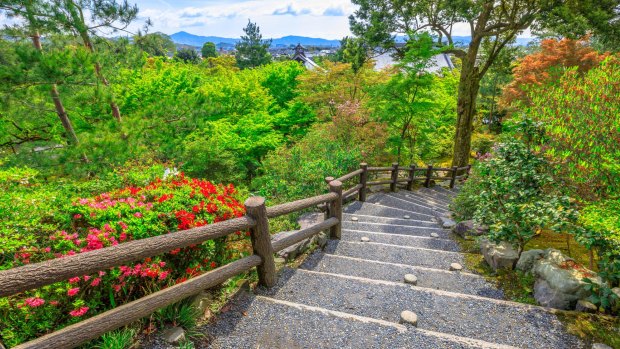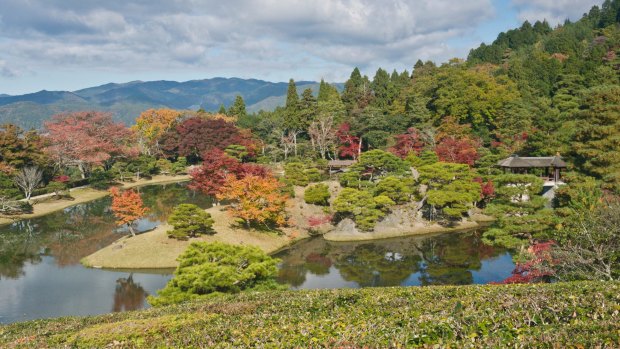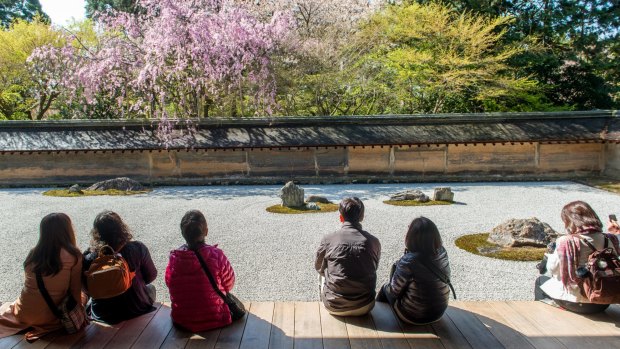This was published 5 years ago
Kyoto, Japan: Where to see the best traditional gardens in Japan

Garden path of a hundred flowers with view of Arashiyama city, Kyoto, Japan. Credit: Alamy
You could charge through most Japanese gardens in minutes and wonder what the fuss is about. Many visitors to Kyoto do. But Japanese gardens aren't about showy fountains, gaudy parterres or sightseeing speed. Abandon your hurry, unwind and turn your mind to contemplation. Note the white blossoms of a well-placed plum tree, ponder the placement of rocks, or autumn leaves fallen onto raked gravel. Sit at a pavilion window and have tea while admiring the garden beyond, and you'll leave a Japanese garden not puzzled but happy.
"A Japanese garden is an ode to nature and our relationship with it," says Australian art historian Mark Hovane, who moved to Kyoto in 1989 and became an expert in Japanese garden design. "The Japanese language is subtle with particular words that describe and celebrate nature, such as komorebi, which refers to dappled sunlight filtering through a tree's leaves. A Japanese garden isn't for playing in but a work of art."
Former imperial capital Kyoto is the epicentre of traditional gardens in Japan, with the country's best ensemble of classical gardens of all varieties. Many are attached to palaces or grand temple complexes, but even so are surprisingly small and intimate. Gardens aren't intended to impress the neighbours, rather they're places into which owners can retreat for a while.

Shugakuin Imperial Villa.Credit: Alamy
"I like the concept that you can create a sanctuary, even in a very small space," Hovane says.
Only careful arrangements supply an illusion of size, with paths looping back on themselves, and well-placed vantage points providing unexpected outlooks or framed views. Hill gardens (tsukiyama) attempt to reproduce natural landscapes in miniature, and are usually best viewed from a hill-top pavilion.
One of the finest hill gardens is attached to Tenryu-ji Temple in western Kyoto, especially lovely in autumn and notable for its borrowed landscape' technique that blends the surrounding Arashiyama hills into the design. Another feature of hill gardens is their wonderful use of moss, with one of the most famous, Saiho-ji Garden, now a World Heritage site.

Mark Hovane.
Another common type of Japanese garden, the tea garden (chaniwa), is centred on a tea house and specifically designed for tea ceremonies. These are crossed by wandering pathways, often lined with stone lanterns, and feature stepping stones across ponds or gravel. Nijo Castle has a fine tea garden, as does Koto-in Temple, though it's currently closed for renovations.
"A tea garden takes you go on a journey towards the tea house, which is seen as a kind of hermitage or sanctuary," Hovane says. "It should give you a sense of being deep in the mountains. Often there's a trim outer garden and an inner garden with bigger trees, as if wilder and more remote.''
The most famous garden type is what foreigners call a Zen garden, more rightly known as a dry garden (karesansui). These are deeply influenced by Zen Buddhism, used for meditation, and noted for their use of raked gravel and well-placed stones or rocks, often imitating water features such as a flowing stream or island-dotted ocean. Rocks are selected for their tortured, misshapen appearance. Only occasionally is a green element introduced, perhaps a bonsai tree or patch of moss.

Japanese tourists enjoy tranquility at Ryoanji Temple. This Zen Buddhist temple is famous for its rock garden.Credit: Alamy
Kyoto, which has many notable Zen temples, has some of Japan's best dry gardens, including one in 13th-century Kennin-ji Temple, and the mossy gardens around the abbot's house at Tofuku-ji Temple. At often-overlooked Konchi-in Temple, a masterful dry garden borrows landscape from the hills behind.
The most famous dry garden in all of Japan is at Ryoan-ji Temple. Its Zen nature is impacted by large numbers of visitors, so visit as early as you can, preferably on a Monday morning, for your moment of contemplation. Here 15 gravel-girt rocks – cunningly placed so you can only see 14 from any one vantage point – might represent the sea, infinity, or a tigress with her cubs, depending on your interpretation.
"People try to read all kinds of meanings into the rock arrangements of dry gardens, but you might as well interpret the patterns of clouds," says Chris Rowthorn, who has lived in Kyoto since 1992 and written dozens of guidebooks on Japan. "In many ways, dry gardens epitomise the most appealing characteristics of Japanese aesthetics, namely simplicity, elegance and restraint."
Although Japanese gardens are immaculately managed – you might even see gardeners clipping pine needles off trees with a pair of scissors – such gardens aren't meant to express control of nature nor the wealth of their owners, as they might in the European tradition. Japanese gardens are invariably petite, subtle and (to the western mind) rather lacking in flowers. However, the springtime plum and cherry blossom season is celebrated with almost religious fervour, and autumn erupts in fabulous colour.
Only stroll gardens (kaiyu) created for aristocrats and emperors tend to be somewhat showy. There are great examples at Sento Palace and Ginkaku-ji (Silver) Temple, which is set in a mossy, wooded hillside at the end of Kyoto's famous Philosopher's Path. Kinkaku-ji (Golden) Temple, a former samurai villa turned Buddhist retreat, has an elegant strolling garden whose paths and bridges supply views referencing famous literary locations. Shin-en Garden at Heian Shrine is especially lovely in the cherry blossom season, but has iris in summer and maples in autumn.
Another outstanding stroll garden graces Shugakuin Villa, though it's seldom seen by overseas visitors, since this is an imperial property and requires organisation in advance through the Imperial Household Agency, with tours only in Japanese. If you have an especial interest in Japanese gardens, however, it's well worth the effort.
All classical Japanese gardens are profoundly influenced by the meditative calm of Buddhism, the harmony and moderation of Confucianism, and the human relationship with nature's rhythms evoked by Taoist ideals. You don't have to be a philosophy expert, however, to appreciate that Japanese gardens are all about delicate charm and the calming of your mind.
Slow your walking down – in a tea garden, a winding path will deliberately prolong your arrival at the tea house – and take time to absorb each garden's delightful details. Listen to the gurgle of a stream, the gulp of a frog, the shiver of wind through bamboo. Sit in a pavilion and appreciate the beauty of nature, even if the tumble of autumn leaves might, as with samurai poets, make you melancholy.
"Get lost in a Kyoto garden and have an experience," Hovane says. "It isn't about the garden with the best or most famous design. Pick something off the beaten track. The best garden is the quietest garden."
TRIP NOTES
Brian Johnston travelled courtesy of the Kyoto Convention & Visitors Bureau.
MORE
FLY
Japan Airlines flies from Melbourne and Sydney to Osaka, an hour on the train from Kyoto. Phone 1300 525 287. See au.jal.com
STAY
Iori Machiya Stay provides renovated machiyia (traditional wooden homes) in varying sizes, with cleaning and concierge services. Phone +81 75 352 0211. See kyoto-machiya.com
TOUR
Aussie expat and landscape expert Mark Hovane offers a Kyoto Garden Experience tour with insights into traditional Japanese gardens. See kyotogardenexperience.com
Chris Rowthorn Tours offers various private, guided walking tours in Kyoto, taking in many of its gardens. See chrisrowthorn.com
Sign up for the Traveller Deals newsletter
Get exclusive travel deals delivered straight to your inbox. Sign up now.